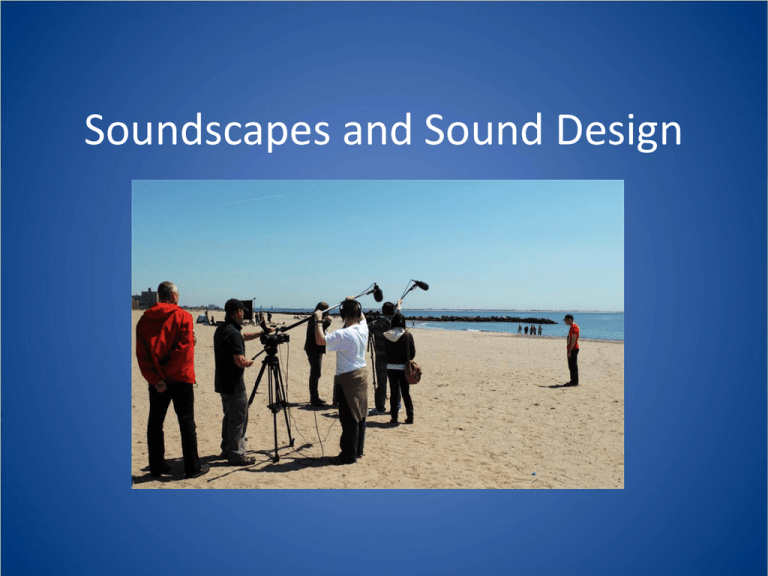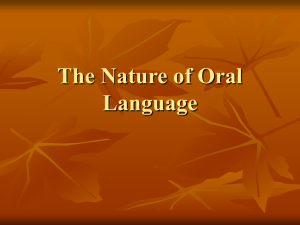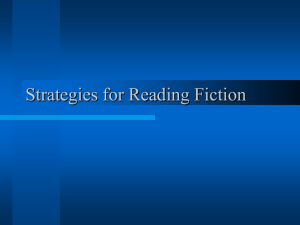Soundscapes and Sound Design
advertisement

Soundscapes and Sound Design Soundscapes and Sound Design I heard a great movie last night! Soundscapes and Sound Design • When was the last time you used or even heard that phrase? • Sound is often so important…you never notice it! • Good sound often ‘makes’ a film, poorly recorded sound or sound mix will destroy it. Soundscapes and Sound Design • Can you name 3 examples where sound is used well in a Movie or a TV programme, drama or documentary? • Music is not a suitable choice as music can drown out a scene and can be a lazy use of an important aspect of what you are watching. • Music for mood is good but we are concerned with the sound mix. How many different sounds can you hear? • Pixar Animation short Pens and paper at the ready...... • Write 3 examples of good sound used in a movie and include: • • • • The name of the movie The type of sound Why it is used Where and when in the movie is it used? Soundscapes and Sound Design • What can sounds be used for? • Why are sounds used? • Sound for mood • Sound for effect • Sound for atmosphere Soundscape • The word “Soundscape" was coined by composer R. Murray Schafer to identify sounds that "describe a place, a sonic identity, a sonic memory, but always a sound that is pertinent to a place" (Wagstaff, G. 2000). Soundscapes • • • • • In Movie terms sounds can be used for: Setting the scene Sounds for what you see on screen Objects used Listening to an image Soundscapes • Sounds can be grouped under 3 headings: • Keynote sounds • Sound signals • Soundmark Keynote Sounds • This is a musical term that identifies the key of a piece, not always audible… the key might stray from the original, but it will return. The keynote sounds may not always be heard consciously, but they “outline the character of the people living there” (Schafer). They are created by nature (geography and climate): wind, water, forests, plains, birds, insects, animals. • In many urban areas, traffic has become the keynote sound. Keynote Sounds • Keynote sounds are those which are heard by a particular society continuously or frequently enough to form a background against which other sounds are perceived. Examples might be the sound of the sea for a maritime community or the sound of the internal combustion engine or Hums in the modern city. • Often keynote sounds are not consciously perceived, but they act as conditioning agents in the perception of other Sound Signals. Sound Signals • These are foreground sounds, which are listened to consciously; examples would be warning devices, bells, whistles, horns, sirens, guns, rivers, a breaking window, cars, planes etc. Soundmark • A term derived from 'landmark‘. • Soundmark is used to refer to a community sound which is unique, or possesses qualities which make it specially regarded or noticed by the people in that community. Soundmarks, therefore, are of cultural and historical significance and merit preservation and protection. • A sound linked to a specific location. Dubbing • An enormous amount of work goes into the sound recording and mixing of films. • MOTH that you saw last week was shot on a stage at Shepperton Film Studios so all atmospheric sounds to ‘set and place’ the drama were dubbed on afterwards. • Natural history films are particularly good for sound mixing, Penguins for example! All sounds created/dubbed • Terry Jones Penguin short Film Sound Stereotypes and Common Logic Flaws • There is a site that lists some of the flaws, a bit geeky really for those film buffs with no life….unlike us! • But obvious and smugly humorous when you consider the examples • Such as….. Do these examples sound familiar? • Animals are never ever silent - dogs whine/bark/yip, cats meow or purr, cows moo, even in cases where most animals wouldn't be making a sound. • Rats, mice, squirrels and other vermin always make the tiny little squeaky noises constantly while they are on screen. • Dolphins always make that same "dolphin chatter" sound when spinning, jumping, etc. • Snakes are always rattling • Crickets in winter and peepers in the fall • Dogs always know who's bad, and bark at them. Insects always sound wet Big Bangs • Bombs always have big, blinking, beeping timer displays. • If something explodes, it takes about a minute for the explosions to stop • Explosions always happen in slow motion. When an explosion occurs, make certain you are running away from the point of detonation so the blast can send you flying, in slow motion, toward the camera. • Bombs "whistle" when falling from a plane Transport • People standing outside a running helicopter can always talk in normal or just slightly louder than normal voices • The tires of any jet screech upon landing • Any airplane in a dive will make a whining noise that will get louder and higher-pitched the longer the dive lasts. • The tyres of any jet screech upon landing • Any airplane in a dive will make a whining noise that will get louder and higher-pitched the longer the dive lasts. • Explosions in space make noise The Wilhelm Scream • A series of short painful screams performed by an actor were recorded in 1951 for the Warner Brother's film "Distant Drums." They were used for a scene where a man is bitten and dragged underwater by an alligator. The recording was archived into the studio's sound effects library -- and it was used in many of their films since. Sound designer Ben Burtt tracked down the scream recording - which he named "Wilhelm" from a character who let out the same scream in "Charge at Feather River (1953)." Ben has adopted the scream as sort of a personal sound signature, and has worked it into as many films as he can. The Wilhelm Scream • Short doc Examples! • Wilhelm Scream examples compilation More on sound • http://filmsound.org/ • http://www.filmsound.org/cliche/ Make a note of as many of the dubbed sounds as you can in the opening sequence too this movie









